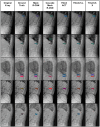Deep learning application of vertebral compression fracture detection using mask R-CNN
- PMID: 39009647
- PMCID: PMC11251057
- DOI: 10.1038/s41598-024-67017-6
Deep learning application of vertebral compression fracture detection using mask R-CNN
Abstract
Vertebral compression fractures (VCFs) of the thoracolumbar spine are commonly caused by osteoporosis or result from traumatic events. Early diagnosis of vertebral compression fractures can prevent further damage to patients. When assessing these fractures, plain radiographs are used as the primary diagnostic modality. In this study, we developed a deep learning based fracture detection model that could be used as a tool for primary care in the orthopedic department. We constructed a VCF dataset using 487 lateral radiographs, which included 598 fractures in the L1-T11 vertebra. For detecting VCFs, Mask R-CNN model was trained and optimized, and was compared to three other popular models on instance segmentation, Cascade Mask R-CNN, YOLOACT, and YOLOv5. With Mask R-CNN we achieved highest mean average precision score of 0.58, and were able to locate each fracture pixel-wise. In addition, the model showed high overall sensitivity, specificity, and accuracy, indicating that it detected fractures accurately and without misdiagnosis. Our model can be a potential tool for detecting VCFs from a simple radiograph and assisting doctors in making appropriate decisions in initial diagnosis.
© 2024. The Author(s).
Conflict of interest statement
The authors declare no competing interests.
Figures




Similar articles
-
Can a Deep-learning Model for the Automated Detection of Vertebral Fractures Approach the Performance Level of Human Subspecialists?Clin Orthop Relat Res. 2021 Jul 1;479(7):1598-1612. doi: 10.1097/CORR.0000000000001685. Clin Orthop Relat Res. 2021. PMID: 33651768 Free PMC article.
-
Deep learning model for automated detection of fresh and old vertebral fractures on thoracolumbar CT.Eur Spine J. 2025 Mar;34(3):1177-1186. doi: 10.1007/s00586-024-08623-w. Epub 2024 Dec 21. Eur Spine J. 2025. PMID: 39708132
-
UANV: UNet-based attention network for thoracolumbar vertebral compression fracture angle measurement.Sci Rep. 2025 Jun 6;15(1):19952. doi: 10.1038/s41598-025-03514-6. Sci Rep. 2025. PMID: 40481023 Free PMC article.
-
[Vertebral fractures: radiological diagnosis, differential diagnosis and prognostic implications].Clin Ter. 2007 Jul-Aug;158(4):355-61. Clin Ter. 2007. PMID: 17953288 Review. Italian.
-
Vertebral compression fractures: Still an unpredictable aspect of osteoporosis.Turk J Med Sci. 2021 Apr 30;51(2):393-399. doi: 10.3906/sag-2005-315. Turk J Med Sci. 2021. PMID: 32967415 Free PMC article. Review.
References
-
- Joshi D, Singh TP. A survey of fracture detection techniques in bone x-ray images. Artif. Intell. Rev. 2020;53:4475–4517. doi: 10.1007/s10462-019-09799-0. - DOI
MeSH terms
Grants and funding
LinkOut - more resources
Full Text Sources
Medical

